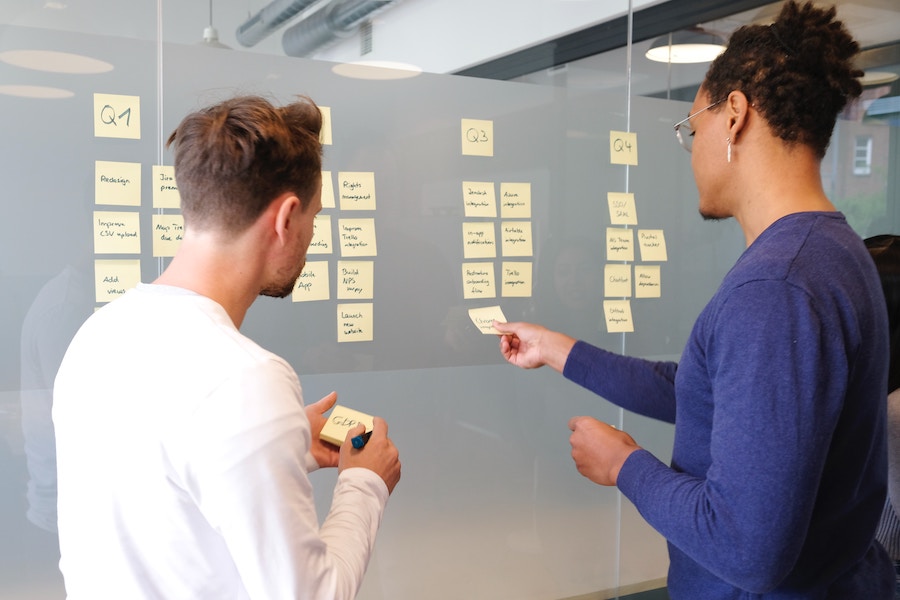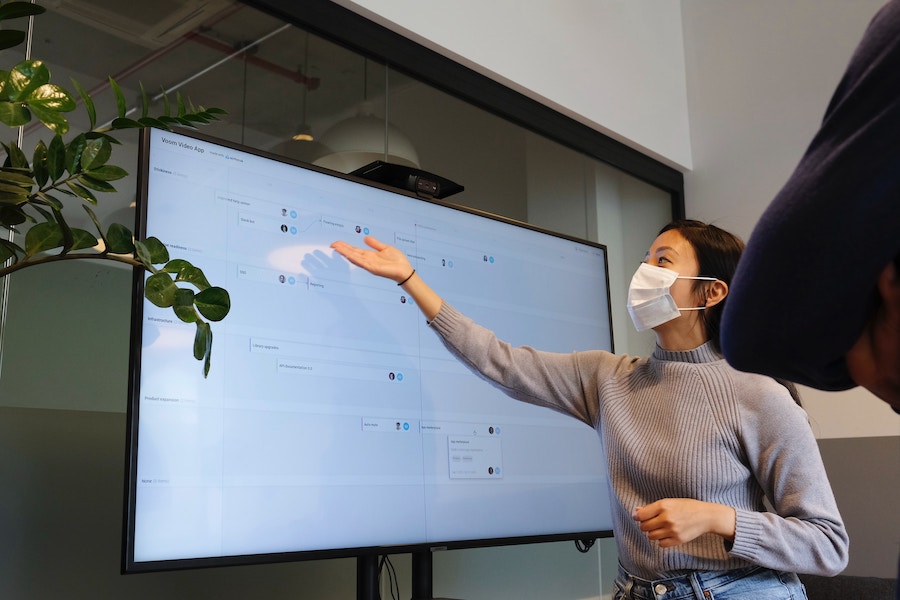Artificial intelligence (AI) is one of the most exciting and disruptive fields of technology today. Artificial intelligence software development has the potential to transform various industries, from healthcare to finance, from education to entertainment. According to a report by Statista, the global AI market size is expected to reach $169.41 billion by 2025.
Developing and deploying AI solutions requires a team of skilled and diverse professionals who can work together effectively. But how do you build an artificial intelligence team to deliver high-quality results and collaborate effectively with your onshore team? Here are some tips to help you get started with the AI development team.
AI team roles
An AI team typically consists of several roles that cover different aspects of the AI lifecycle, from ideation to deployment. Depending on the size and scope of the project, some AI team roles may be combined or split into sub-roles. Here are some of the common roles in an AI team:
-
AI Product Manager
The AI product manager ensures that the AI solutions are ethical, fair, and responsible. They are responsible for identifying and addressing any potential ethical issues or risks that may arise from the use or misuse of AI, such as bias, discrimination, privacy, or accountability. They also develop and implement ethical guidelines and best practices for designing, developing, and deploying AI solutions, as well as educating and raising awareness among the AI team and other stakeholders about the ethical implications of AI.
-
AI Engineer
The AI engineer builds and maintains the AI systems using tools and frameworks such as TensorFlow, PyTorch, or Azure Machine Learning or any other technology selected specifically for your project. They are responsible for coding, testing, debugging, and deploying the AI models, as well as optimizing their performance and scalability. They also collaborate with other engineers and data scientists to integrate AI solutions with existing systems and platforms.
-
Data Scientist
This is the person who analyzes and interprets the data that feeds into the AI models using statistical and machine learning techniques. They are responsible for finding patterns, insights, and trends in the data, as well as defining the business problems and objectives that the AI models aim to solve. They also design, train, evaluate, and refine the AI models using various algorithms and methods such as regression, classification, clustering, or deep learning.
-
Data Engineer
This is the person who collects, cleans, and organizes the data that is used by data scientists and AI engineers. They are responsible for creating and managing the data pipelines, databases, and storage systems that store and process large volumes of structured and unstructured data. They also ensure the quality, security, and accessibility of the data using various tools and technologies such as SQL, Hadoop, Spark, Kafka or any other technologies that have been expressly chosen for your project.
Moreover, the data engineers also may act as a data analyst. They deal with exploring, cleaning, and preparing the data that is used by the data scientist or the AI engineer. They have a background in data analysis, programming, and business intelligence tools. They also have skills in data wrangling, feature engineering, etc.
-
Machine Learning Engineer
The machine learning engineer is a part of the AI research team responsible for designing, implementing, and optimizing the machine learning algorithms that are used by the AI solution. They have a background in computer science or engineering, as well as knowledge and experience in various machine learning techniques, such as supervised learning, unsupervised learning, deep learning, etc. They also have skills in machine learning frameworks, libraries, tools, etc.
ML engineers also may carry out machine learning research that helps in developing new or improved machine learning methods for the upcoming AI solution. The research requires a background in computer science or engineering, as well as knowledge and experience in various machine learning techniques.
These are just some of the roles that make up an AI team. Depending on the size, scope, and complexity of the project, there may be more or fewer roles involved. The important thing is that each role has a clear purpose and contributes to the success of the AI product or service.
AI team structure: options for building an AI team
Building an AI team is a challenging task that requires careful planning and consideration of various factors. One of the factors is the location of the team members, which can have a significant impact on the cost, quality, and efficiency of the AI project. In this blog post, we will explore the different variants of building an AI team based on their location, such as remote, nearshore, onshore, and hybrid models.
Remote AI team
A remote or distributed AI team is an artificial intelligence company that is located in a different country or continent from the client or the main office. This variant offers some advantages, such as lower labor costs, access to a large pool of talent, and flexibility in working hours.
However, it also comes with some challenges, such as communication barriers, cultural differences, legal issues, and quality control. Therefore, to build a remote team for AI, you require a clear vision, a well-defined scope, and a strong management system to ensure the success of the project.
Nearshore AI team
A nearshore AI team is an artificial intelligence team that is located in a neighboring or nearby country from the client or the main office. This variant has some similarities with the remote model but with less distance and time difference. This can facilitate communication, collaboration, and coordination among the team members and the client.
However, it can also entail higher costs, competition for talent, and political risks. Therefore, building a nearshore AI team requires thorough research, a solid contract, and a trustful relationship with the partner.

Source: Unsplash
Hybrid AI team
A hybrid AI team is a team that combines different variants of location-based models. For example, it can have some AI team members working nearshore and some working in a remote team. This variant can offer the best of both worlds: cost-effectiveness, scalability, diversity, and quality. However, it can also pose some challenges: complexity, coordination, integration, and communication. Therefore, building a hybrid AI team requires a clear strategy, a robust infrastructure, and a collaborative mindset.
However, AI hiring levels in the remote industry rose in May 2022. Let’s figure out why.
AI development team: Why сhoose remote
Artificial intelligence (AI) is transforming the world of business in many ways. From automating tasks to enhancing customer experience, AI can help businesses improve their efficiency, productivity, and profitability. However, developing and implementing AI solutions can be challenging, especially for small and medium-sized enterprises (SMEs) that need more resources, expertise, and infrastructure to do so. That’s where remote AI teams come in.
Remote AI teams are groups of professionals (Generative AI providers, for instance) who work remotely from different countries and provide AI services to clients across the globe. By hiring a remote AI team, you can leverage the benefits of AI without having to invest in hiring, training, and managing an in-house team. Here are some of the reasons why you should choose a remote AI team for your business:
Cost savings

You can also save on infrastructure, equipment, and software costs by outsourcing your AI needs to a team that already has them. Additionally, you can avoid the expenses of recruitment, retention, and employee benefits by hiring a remote team on a project basis.
Access to talent
Remote AI teams have access to a large pool of qualified and experienced professionals who specialize in various aspects of AI, such as machine learning, natural language processing, computer vision, AI strategy consulting, and more. You can find the best fit for your project based on your specific requirements and preferences. You can also benefit from the diversity of perspectives, skills, and knowledge that a remote team can bring to your project.
Scalability
Remote AI teams can easily scale up or down depending on your project needs and budget. You can hire more or fewer team members as per your demand and only pay for what you use. You can also adjust the scope and timeline of your project as needed without affecting your core operations. This gives you more flexibility and control over your project outcomes.
Quality
Remote AI teams are committed to delivering high-quality work that meets or exceeds your expectations. They follow industry standards and best practices to ensure the accuracy, reliability, and security of your AI solutions. They also use the latest tools and technologies to keep up with the evolving trends and demands of the AI market. Moreover, they communicate regularly with you to provide updates, feedback, and support throughout the project lifecycle.
Competitive edge
By choosing a remote AI team, you can gain a competitive edge over your rivals that may not have access to or afford the same level of AI expertise and innovation. You can use AI to optimize your business processes, enhance your customer satisfaction, increase your revenue, and create new opportunities for growth. You can also stay ahead of the curve by adopting new AI solutions that can give you an advantage in your industry.

Source: Unsplash
As you can see, there are many benefits to choosing a remote AI team for your business. However, not all remote AI teams are created equal. You need to do your research and due diligence before hiring a remote team to ensure that they are trustworthy, competent, and compatible with your business goals and culture.
Steps to build a remote team for AI projects
Finding and hiring qualified AI talent can be challenging, especially in regions where the demand exceeds the supply. That’s why many companies are looking for ways to build remote teams for AI projects, where they can leverage the skills and expertise of professionals from different countries and cultures.
But how do you build an effective and productive remote team for AI projects? Here are some steps to guide you through the process:
-
Define your AI goals and requirements
Before you start looking for an AI team, you need to have a clear idea of what you want to achieve with AI and what kind of skills and expertise you need. For example, do you need a team that can handle data collection, preprocessing, modeling, deployment, and maintenance? Or do you only need a team that can focus on a specific aspect of the AI pipeline? Do you need a team that can work with a specific framework, tool, or platform? Do you need a team that can communicate in a certain language or timezone? Having a clear vision of your AI goals and requirements will help you narrow down your search and find the best fit for your project.

Source: Unsplash
-
Choose a suitable location
The location of your remote team can have a significant impact on your project’s success. You need to consider factors such as time zone differences, language barriers, cultural differences, legal and regulatory issues, infrastructure and connectivity, and cost of living. Ideally, you want to choose a location that has a strong pool of AI talent, a favorable business environment, and a compatible culture with your own.
-
Search for the right AI partner
Once you have defined your AI goals and team location, you need to find an AI partner that can meet them. There are many factors to consider when choosing a remote AI partner, such as their portfolio of AI business cases, reputation, experience, pricing, quality, communication, and culture. You should look for a remote AI partner who has a proven track record of delivering successful AI projects for clients in your industry or domain. You should also look for a remote AI partner that has a strong team of AI experts who can handle the complexity and challenges of your project. You should also look for a remote AI partner that offers competitive pricing, transparent communication, and flexible collaboration models.
-
Establish clear roles and responsibilities
After you have chosen your remote AI partner, you need to establish clear roles and responsibilities. You should assign a project manager or a point of contact for each team who can coordinate the tasks, monitor the progress, and resolve any issues that may arise. You should also define the scope, deliverables, milestones, timelines, and quality standards for your project.
-
Foster communication and select collaboration tools
Communication and collaboration are essential for any team, but especially for remote teams that work remotely and across different time zones. You need to set up reliable and secure tools that allow you to communicate effectively with your remote team members, share files and documents, track progress and performance, and provide feedback and support. Some examples of tools that you can use are Slack, Zoom, Google Drive, GitHub, Jira, etc.
-
Leverage the best tools and practices
To ensure the smooth and efficient operation of your AI team, you need to leverage the best tools and practices for remote collaboration. You should use cloud-based platforms and tools that can enable your AI team to access, store, share, and process data securely and easily. You should also use communication and collaboration tools that can facilitate real-time interaction, file sharing, screen sharing, video conferencing, and instant messaging. You should also use project management and workflow tools that can help you track the tasks, deadlines, status, and performance of your AI team.

Source: Unsplash
-
Build trust and rapport
Assembling an AI team is not only about finding the right talent and technology but also about creating a positive and productive work environment. You should foster trust and engagement between your onshore and remote teams by encouraging open communication, feedback, recognition, and appreciation. You should also provide opportunities for learning, development, and growth for your AI team by offering training, mentoring, coaching, and career advancement. You should also celebrate the achievements and successes of your AI team by rewarding them with incentives, bonuses, or recognition.
Building an AI development team can be a smart and strategic move for your business if you follow these tips. You can access a larger pool of talent, reduce costs, and accelerate your artificial intelligence projects while maintaining high-quality standards and outcomes.
Conclusion
The field of artificial intelligence (AI) presents a world of possibilities for transforming various industries and reshaping the way we live and work. The potential of AI is vast, with the global AI market projected to reach staggering heights in the coming years. However, harnessing the power of AI requires a well-structured and skilled team capable of delivering high-quality results and working harmoniously with other stakeholders.
Start working with your perfect AI team today!
Collaboration with the best AI companies can provide a competitive edge and improved efficiency for businesses. Contact InData Labs to stay adaptable and open to new trends and technologies to excel in the dynamic world of AI.



